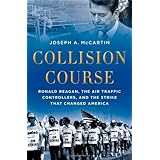
Average Reviews:

(More customer reviews)Are you looking to buy Collision Course: Ronald Reagan, the Air Traffic Controllers, and the Strike that Changed America? Here is the right place to find the great deals. we can offer discounts of up to 90% on Collision Course: Ronald Reagan, the Air Traffic Controllers, and the Strike that Changed America. Check out the link below:
>> Click Here to See Compare Prices and Get the Best Offers
Collision Course: Ronald Reagan, the Air Traffic Controllers, and the Strike that Changed America ReviewAnyone who remembers 1981 remembers the day the air traffic controllers went out on strike. President Reagan ordered them to report back to work within 48 hours or else. Those who didn't (only 10% of those striking returned to work) were fired.In Collision Course, labor historian Joseph McCartin has written an account of the formation of PATCO (the Professional Air Traffic Controllers' Organization), the strike, and what happened after Reagan fired the controllers.
Collision Course is no dull labor history. It's told almost like a thriller. McCartin refers early in the book to Arthur Hailey's novel Airport. I think he may have been inspired by Hailey to keep it punchy, because even though you know how the PATCO story ends, it's still quite exciting to read about the events leading up to the inevitable clash of union and employer.
McCartin tells many sides to the story that I wasn't aware of at the time. Reagan's decision to act tough had just as much to do with foreign policy as it did with labor relations. He was dealing with the Soviets and needed to appear decisive and ruthless. McCartin also tells how the controller population was overwhelmingly male, white, and ex-military. It's possible (although McCartin doesn't explore this) that their tendency to see things from a similar point of view was part of their downfall. PATCO dismissed the concerns of the few blacks and women among their numbers, and they also failed to consider how their increasing demands might appear to the American taxpayers.
As gripping as the story is, what does it have to do with us today? Lots, according to McCartin, and he makes a convincing case. Unions were reluctant for decades after the PATCO strike to push back against a steady loss of benefits and wages, because employers figured if the president could break a strike, they could too. Even in 2011, Wisconsin Governor Scott Walker invoked Reagan's memory to justify his successful bill to eliminate bargaining rights for public workers. Never mind that Reagan acknowledged PATCO's right to bargain and only drew the line at the illegal strike. After the mass firing, unions became less and less popular, and the balance of power between employer and employee tilted heavily in favor of the employer.
"They can't fire all of us." What had been a rallying cry for the PATCO controllers before the strike became gallows humor to post-PATCO workers, an ironic reminder that yes, they can fire all of us.Collision Course: Ronald Reagan, the Air Traffic Controllers, and the Strike that Changed America OverviewIn August 1981, the Professional Air Traffic Controllers Organization (PATCO) called an illegal strike. The new president, Ronald Reagan, fired the strikers, establishing a reputation for both decisiveness and hostility to organized labor. As Joseph A. McCartin writes, the strike was the culmination of two decades of escalating conflict between controllers and the government that stemmed from the high-pressure nature of the job and the controllers' inability to negotiate with their employer over vital issues.PATCO's fall not only ushered in a long period of labor decline; it also served as a harbinger of the campaign against public sector unions that now roils American politics.Collision Course sets the strike within a vivid panorama of the rise of the world's busiest air-traffic control system. It begins with an arresting account of the 1960 midair collision over New York that cost 134 lives and exposed the weaknesses of an overburdened system. Through the stories of controllers like Mike Rock and Jack Maher, who were galvanized into action by that disaster and went on to found PATCO, it describes the efforts of those who sought to make the airways safer and fought to win a secure place in the American middle class.It climaxes with the story of Reagan and the controllers, who surprisingly endorsed the Republican on the promise that he would address their grievances.That brief, fateful alliance triggered devastating miscalculations that changed America, forging patterns that still govern the nation's labor politics. Written with an eye for detail and a grasp of the vast consequences of the PATCO conflict for both air travel and America's working class, Collision Course is a stunning achievement.
Want to learn more information about Collision Course: Ronald Reagan, the Air Traffic Controllers, and the Strike that Changed America?
>> Click Here to See All Customer Reviews & Ratings Now
0 comments:
Post a Comment